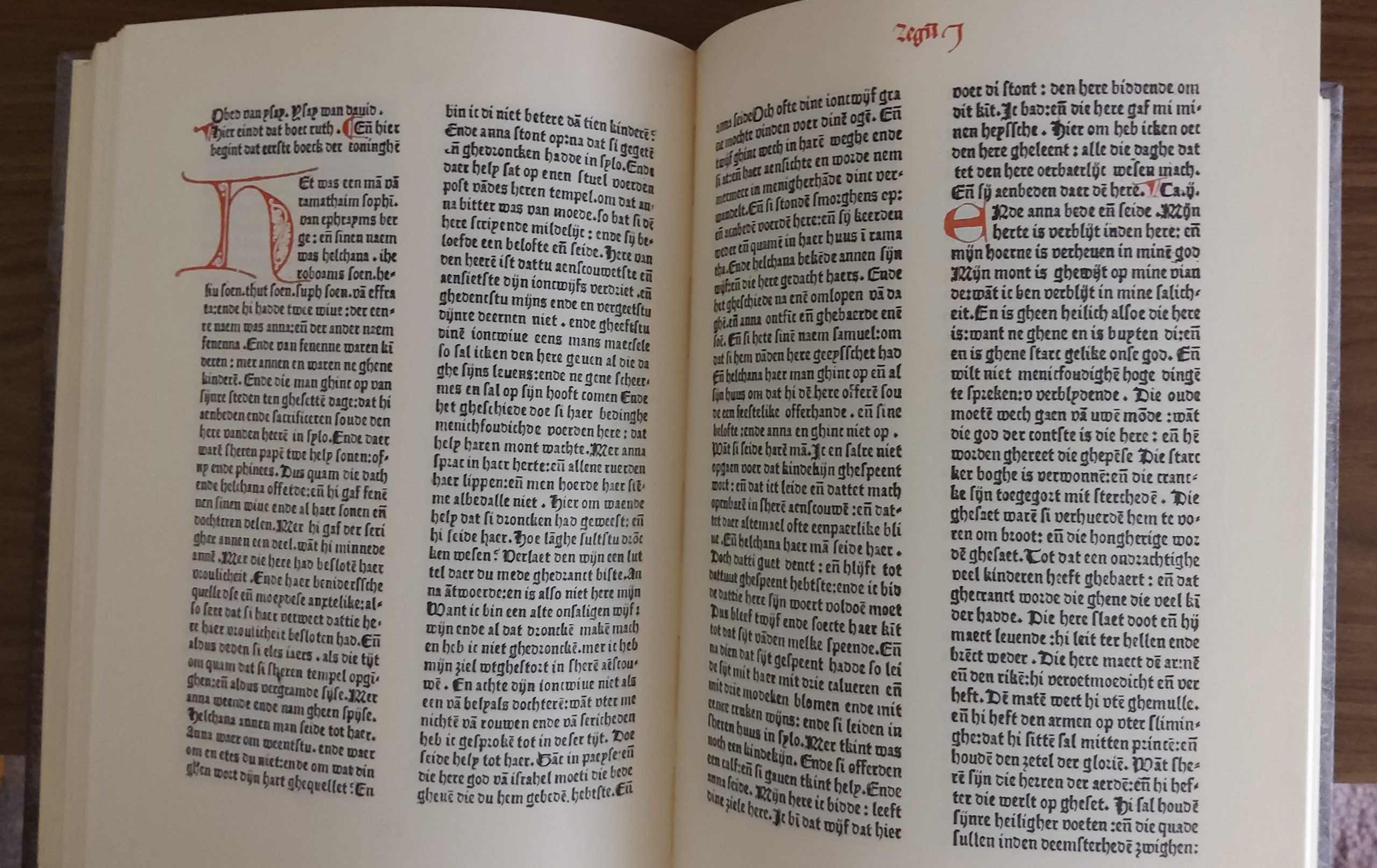
Two pages from the first Bible in Dutch language. De Delftsche Bijbel 1477
Genesis 1:6-8
⁶Then God said, “Let there be an expanse in the midst of the waters, and let it separate the waters from the waters.” ⁷God made the expanse, and separated the waters which were below the expanse from the waters which were above the expanse; and it was so.
⁸God called the expanse heaven. And there was evening and there was morning, a second day.
Study
Let there be a firmament
This term, which is an exact translation of the word used by the Septuagint, or Greek translation of the Old Testament, by no means expresses the sense of the word used by Moses, רקיע (rakiang), which merely means extension or expansion.
And as this extension or expansion was to be in the midst of the waters, and was to divide the waters from the waters, it chiefly, if not solely, means the air or atmosphere which separates the water in the clouds from that which is in and upon the earth.
Thus the second great production of the Almighty was the element which is next in simplicity, purity, activity, and power, to the light, and no doubt was also used by Him as an agent in producing some subsequent effects, especially in gathering the waters into one place.
It is true, we afterward read of the sun, moon, and stars being set in the firmament of heaven: but the meaning seems only to be that they are so placed as only to be visible to us through the atmosphere.
The second act of creative power bears upon the deep of waters, over which the darkness had prevailed, and by which the solid crust was still overlaid.
This mass of turbid and noisy water must be reduced to order, and confined within certain limits, before the land can be reached.
According to the laws of material nature, light or heat must be an essential factor in all physical changes, especially in the production of gases and vapors. Hence, its presence and activity are the first thing required in instituting a new process of nature.
Air naturally takes the next place, as it is equally essential to the maintenance of vegetable and animal life. Hence, its adjustment is the second step in this latest effort of creation.
For this purpose God now calls into existence the expanse. This is that interval of space between the earth on the one side and the birds on the wing, the clouds and the heavenly bodies on the other, the lower part of which we know to be occupied by the air.
This will appear more clearly from a comparison of other passages in this chapter (Genesis 1:14, 1:20).
A firmament
This is the Latin translation of the Greek word used by the translators of the Septuagint Version.
Undoubtedly it means something solid; and such was the idea of the Greeks, and probably also of the Hebrews.
As such it appears in the poetry of the Bible, where it is described as a mighty vault of molten glass (Job 37:18), upheld by the mountains as pillars (Job 26:11; 2 Samuel 22:8), and having doors and lattices through which the Deity pours forth abundance (Genesis 7:11; Psalms 78:23).
Even in this “Hymn of Creation” we have poetry, but not expressed in vivid metaphors, but in sober and thoughtful language.
Here, therefore, the word rendered “firmament” means an expanse.
If, as geologists tell us, the earth at this stage was an incandescent mass, this expanse would be the ring of equilibrium, where the heat supplied from below was exactly equal to that given off by radiation into the cold ether above.
And gradually this would sink lower and lower, until finally it reached the surface of the earth; and at this point the work of the second day would be complete.
And let it be dividing between water and water.
It appears that the water in a liquid state was in contact with another mass of water, in the shape of dense fogs and vapors; not merely overhanging, but actually resting on the waters beneath.
The object of the expanse is to divide the waters which are under it from those which are above it. Hence, it appears that the thing really done is, not to create the space that extends indefinitely above our heads (which, being in itself no thing, but only room for things, requires no creating), but to establish in it the intended disposition of the waters in two separate masses, the one above, and the other below the intervening expanse.
This we know is effected by means of the atmosphere, which receives a large body of water in the state of vapor, and bears up a visible portion of it in the form of clouds.
These ever-returning and ever-varying piles of mist strike the eye of the unsophisticated spectator; and when the dew is observed on the grass, or the showers of rain, hail, and snow are seen falling on the ground, the conclusion is obvious – that above the expanse, be the distance small or great, is laid up an unseen and inexhaustible treasury of water, by which the earth may be perpetually bedewed and irrigated.
The aqueous vapor is itself, as well as the element with which it is mingled, invisible and impalpable; but when condensed by cold it becomes apparent to the eye in the form of mists and clouds, and, at a certain point of coolness, begins to deposit itself in the palpable form of dew, rain, hail, or snow.
As soon as it becomes obvious to the sense it receives distinguishing names, according to its varying forms. But the air being invisible, is unnoticed by the primitive observer until it is put in motion, when it receives the name of wind.
The space it occupies is merely denominated the expanse; that is, the interval between us and the various bodies that float above and hang upon nothing, or nothing perceptible to the eye.
The state of things before this creative movement may be called one of disturbance and disorder, in comparison with the present condition of the atmosphere. This disturbance in the relations of air and water was so great that it could not be reduced to the present order without a supernatural cause.
Whether any other gases, noxious or innocuous, entered into the constitution of the previous atmosphere, or whether any other ingredients were once held in solution by the watery deep, we are not informed.
Whether any volcanic or plutonic violence had disturbed the scene, and raised a dense mass of gaseous damp and fuliginous matter into the airy region, is not stated.
How far the disorder extended we cannot tell.
We are merely certain that it reached over all the land known to man during the interval between this creation and the deluge. Whether this disorder was temporary or of long standing, and whether the change was effected by altering the axis of the earth’s rotation, and thereby the climate of the land of primeval man, or by a less extensive movement confined to the region under consideration, are questions on which we receive no instruction, because the solution does not concern our well-being.
As soon as human welfare comes to be in any way connected with such knowledge, it will by some means be made attainable.
The introduction of the expanse produced a vast change for the better on the surface of the earth. The heavy mass of murky damp and aqueous steam commingling with the abyss of waters beneath is cleared away.
The fogs are lifted up to the higher regions of the sky, or attenuated into an invisible vapor. A leaden mass of clouds still overshadows the heavens. But a breathing space of pure pellucid air now intervenes between the upper and lower waters, enveloping the surface of the earth, and suited for the respiration of the flora and fauna of a new world.
Let it be noted that the word “be” is here again employed to denote the commencement of a new adjustment of the atmosphere. This, accordingly, does not imply the absolute creation on the second day of our present atmosphere: it merely indicates the constitution of it out of the materials already at hand, – the selecting and due apportionment of the proper elements; the relegation of all now foreign elements to their own places; the dissipation of the lazy, deadening damps, and the establishment of a clear and pure air fit for the use of the future man.
Any or all of these alterations will satisfy the form of expression here adopted.
Read more of these messages at: https://devotionals.harryschoemaker.nl
Download your Bible pictures from: http://bijbelplaatjes.nl
Follow me on Twitter: @schoemakerharry
Email: devotionals@harryschoemaker.nl





